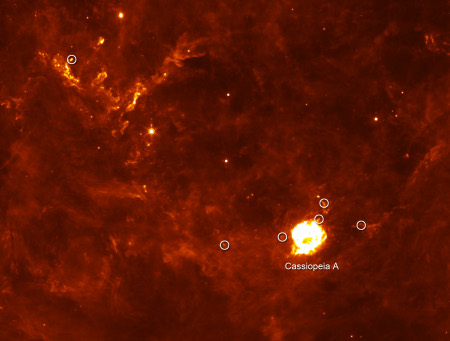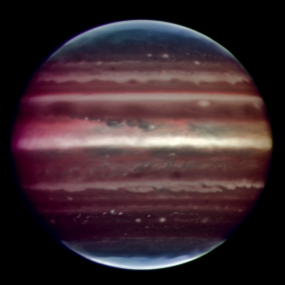Again and again I’m amazed by our growing ability to tease information out of apparent noise. Consider the problem of viewing celestial objects from Earth’s surface. The image below demonstrates the latest way to remove atmospheric blur that would otherwise bedevil a ground-based telescope. We’re looking at Jupiter through a prototype instrument called the Multi-Conjugate Adaptive Optics Demonstrator (MAD). This is a form of adaptive optics that uses two guide stars (or in this case, two of Jupiter’s moons) instead of one as references, allowing a wider field of view.
Adaptive optics involves real-time corrections made at high speed, feeding a computer-controlled deformable mirror that interprets the atmospheric distortion by examining light from the chosen guide stars. Normally, the method works with a single guide star, but that allows for atmospheric corrections only in a tiny region of sky. The new MAD methods significantly overcome this limitation. The false-color infrared Jupiter we see here is proof of the result, not only startlingly crisp but scientifically useful in the identification of an apparent shift to the south in the planet’s equatorial haze, a change that shows up clearly when this image is compared to Hubble images from 2005.
Image (click to enlarge): Jupiter in infrared light, taken on the night of 17 August 2008 with the Multi-Conjugate Adaptive Optics Demonstrator (MAD) prototype instrument mounted on ESO’s Very Large Telescope. This false colour photo is the combination of a series of images taken over a time span of about 20 minutes, through three different filters (2, 2.14, and 2.16 microns). The image sharpening obtained is about 90 milli-arcseconds across the whole planetary disc, a real record over similar images taken from the ground. This corresponds to seeing details about 300 km wide on the surface of the giant planet.
As adaptive optics continues to sharpen our view from the ground, the way we play with light gets more ingenious all the time. Scientists studying the Cassiopeia A supernova remnant are now working with ‘light echoes’ — hot spots in silicate dust near the remnant that are the result of a short pulse of ultraviolet radiation and X-rays that occurred with the supernova. Essentially, we’re looking at an explosion whose light reached the Earth in the 17th Century, but we’re now able to use the expanding gas cloud to examine energy that is being re-radiated from the blast at infrared wavelengths. See this news release for more.
The image below identifies the location of the light echoes. As to the nature of light echoes themselves, here’s how Eli Dwek (NASA GSFC) and Richard Arendt (University of Maryland), who used Spitzer data in this work, define the phenomenon in their paper:
Short-lived luminous sources can produce echoes of their outburst in the ISM. These echoes can be manifested as line emission from the gas, or re?ected and thermally re-radiated light from the dust in the ISM. They can be used to probe the morphology of the interstellar medium (ISM) through which they are expanding and to reconstruct the historical record of the temporal behavior of the light source.

Image: The Cassiopeia A supernova’s first flash of radiation makes six clumps of dust (circled) unusually hot. Credit: NASA/JPL-Caltech/E. Dwek and R. Arendt.
Out of this work comes an analysis of the burst that produced the echoes and an examination of the interstellar clouds that gave rise to them. The triggering event was the pulse of UV and X-rays of the original shock wave triggered by the formation of a neutron star, a blast that blew the star’s outer layers apart and preceded the flash in visible light. We have evidence that such ‘shock breakout’ occurs in a long pulse that the Swift satellite detected in 2008 from galaxy NGC 2770. That pulse was followed by the appearance of a supernova in that galaxy a few days later.
The paper on this work is Dwek and Arendt, “Infrared Echoes Reveal the Shock Breakout of the Cas A Supernova,” Astrophysical Journal 685 (October 1, 2008), pp. 976–987 (abstract). Like the adaptive optics refinements we looked at above, this work reminds us of the way science continues to transcend apparent limitations. Atmospheric distortion is rapidly being overcome. And in a sense, astronomers are learning to overcome the limitations of time by finding light echoes that carry at least part of a cataclysmic supernova’s history.



Hi Paul;
The growing ability to tease out signals from background noises is amazing.
An interesting example is the use of hyper-spectral imaging from satallites and/or from aircraft based imaging systems to study the health of crops, look for burried ancient archeological sites, and to study the health of woodlands.
I can imagine such technology, if it has not already, being deployed to study interstellar gas clouds, the gravitational pull of Cold Dark Matter on interstellar and intergalactic gas and dust via wide field imaging techniques, and the detailed study of the surfaces of the planets within our own solar system as well as the many moons within our solar system, especially Europa, Titan, Encedales, and the many other large moons.
I watched a program a couple of days ago about the Cassini Space Probe and the landing of a probe on Titan wherein the signal that the probe had landed came from the probe itself and, if I am not mistaken, not through the intermediary relay station that was sent to the same system on the Cassini Mission. A relay station was used however to send back the higher resolution data aquired by the lander such as photographic imagery etc. The point is that the initial signal from the lander must not have been much more powerful than that of a cell phone, and to be able to pick up the signal from over a billion miles just amazes me.
Thanks;
Jim
Jupiter spins fast. In 20 minutes it rotates about 12 degrees. There must be additional post-processing to overlay the images, including adjustment for the spherical distortion from our viewpoint due to that rotation and limbs rotating in and out of view. Impressive.
Funding for Adaptive Optics in the United States by the National Science Foundation 2006-2009: An Update
Authors: Jay A. Frogel
(Submitted on 8 Sep 2009)
Abstract: In 2006 I published an article in GeminiFocus that examined funding for astronomical adaptive optics related technology and instrumentation in the United States from 1995 through mid-2006. That article concluded that based on projections then current, AO implementation on public and private telescopes in the U.S. will soon seriously lag that on the ESO VLT as measured by funds available.
It called for a significant infusion of public funds for AO development and implementation so that when combined with private funds, the U.S. astronomical community as a whole would be able to take full advantage of AO systems on both public and private telescopes.
In 2006 I estimated that the total amount of public (NSF) funds that would be available in 2009 for AO related non-science activities would be about $6M.
This article updates the analysis done in my previous article. I show that for 2009 the funds for AO related non-science activities are about $7M in spite of the termination of the AODP program. Federal stimulus funds via the ARRA may be responsible for a not insignificant part of this $7M. I make the probably optimistic prediction that in 2010 there will be $6M in new NSF funds avaialbe for AO related non-science work.
Thus there has been no significant real increase of public funding for AO development and implementation. If private funding in the US and the level of ESO AO funding is close to the values predicted in my previous article, then ESO on one observatory, is outspending all US AO efforts spread over about a dozen observatories by a factor of three.
Comments: 14 pages with embedded figures and tables
Subjects: Instrumentation and Methods for Astrophysics (astro-ph.IM); Cosmology and Extragalactic Astrophysics (astro-ph.CO); Galaxy Astrophysics (astro-ph.GA)
Cite as: arXiv:0909.1543v1 [astro-ph.IM]
Submission history
From: Jay A. Frogel [view email]
[v1] Tue, 8 Sep 2009 18:42:22 GMT (183kb)
http://arxiv.org/abs/0909.1543